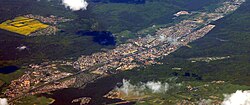Wejherowo
| Wejherowo | |||
|---|---|---|---|

Town from a bird's eye view
|
|||
|
|||
| Coordinates: 54°36′N 18°15′E / 54.600°N 18.250°E | |||
| Country |
|
||
| Voivodeship | Pomeranian | ||
| County | Wejherowo County | ||
| Gmina | Wejherowo (urban gmina) | ||
| Established | 1643 | ||
| Town rights | 1650 | ||
| Government | |||
| • Mayor | Krzysztof Hildebrandt | ||
| Area | |||
| • City | 25.65 km2 (9.90 sq mi) | ||
| Highest elevation | 110 m (360 ft) | ||
| Lowest elevation | 24 m (79 ft) | ||
| Population (2012) | |||
| • City | 50,310 | ||
| • Density | 2,000/km2 (5,100/sq mi) | ||
| • Metro | 130,000 | ||
| Time zone | CET (UTC+1) | ||
| • Summer (DST) | CEST (UTC+2) | ||
| Postal code | 84-200 to 84-204 | ||
| Area code(s) | +48 58 | ||
| Car plates | GWE | ||
| Website | http://www.wejherowo.pl | ||
Wejherowo [vɛi̯xɛˈrɔvɔ] (Kashubian: Wejrowò, German: Neustadt in Westpreußen) is a town in Gdańsk Pomerania, northern Poland, with 50,310 inhabitants (2012). It has been the capital of Wejherowo County in Pomeranian Voivodeship since 1999; previously, it was a town in Gdańsk Voivodeship (1975–1998).
Wejherowo is located in Pomeralia, approximately 11 km (7 mi) west of the town of Rumia, 32 kilometres (20 miles) east of the town of Lębork and 35 km (22 mi) north-west of the regional metropole of Gdańsk, in the broad glacial valley of the river Rheda at an altitude of 30 metres (98 feet) above sea level.
Wejherowo was founded in 1643 as "Wejher's Freedom" (Polish Wola Wejherowska), by the voivode of the Malbork Voivodeship, and ardent Polish patriot, Jakub Wejher. According to the founder's will, the citizens of the new settlement were to possess the same city rights as other towns in the region, hence the place granted Kulm law. The town's privileges, received in 1655, were confirmed by King John II Casimir Vasa of Poland on the Reichstag.
Wejher, who survived the Smolensk War, built two churches in the new settlement (The Holy Trinity and Saint Ann). He also brought in Franciscan fathers, built a monastery, and founded a calvary, consisting of 26 chapels, aligned along the border of the town forest, which were built during 1646–55. According to the founder's written statement of 1655, all honorable persons, independent of their nationality, were invited to become citizens of the new settlement if they would pay a citizen fee of ten gulden each.
...
Wikipedia



